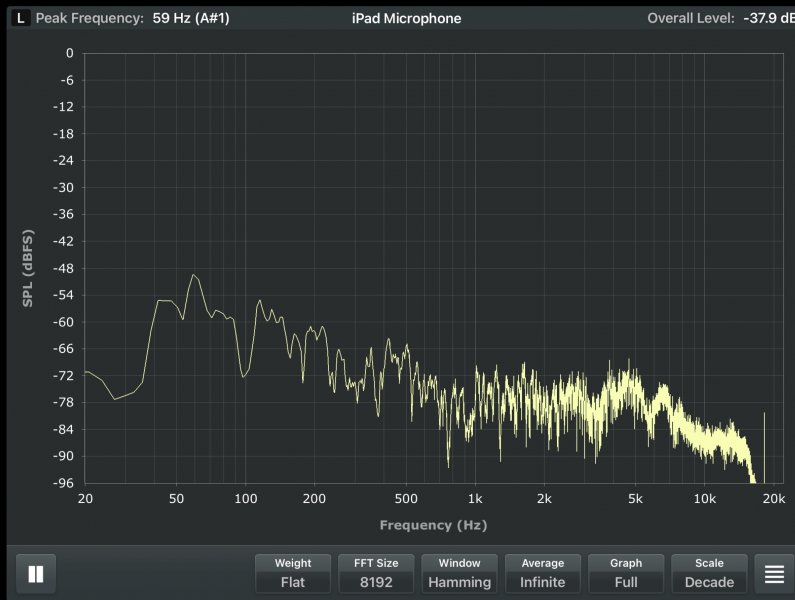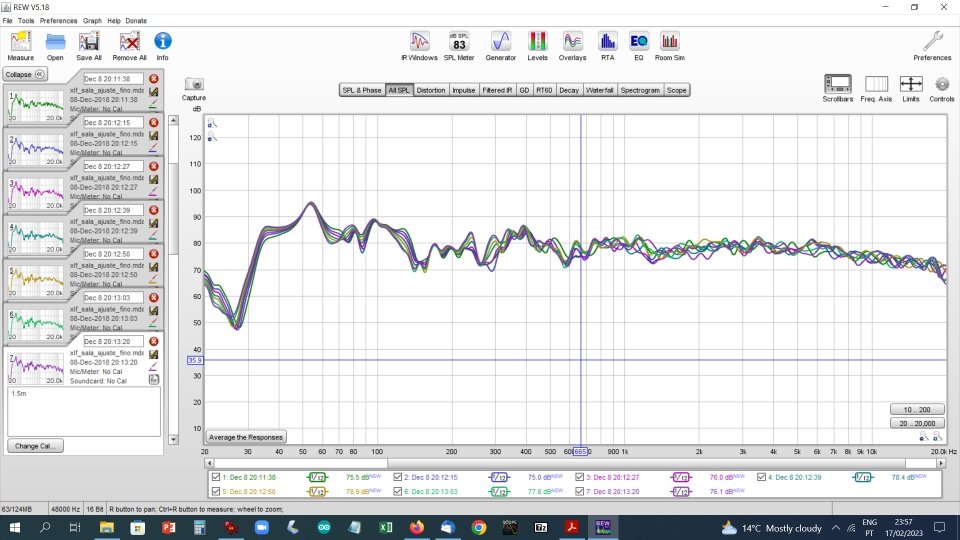Ron’s New System
- Thread starter Ron Resnick
- Start date
You are using an out of date browser. It may not display this or other websites correctly.
You should upgrade or use an alternative browser.
You should upgrade or use an alternative browser.
We don't talk about it enough, but the utility of WBF as a globally crowdsourced source of audio information is incredible.
Last edited:

By golly, I think Rune and Anthony did a darn good job!
Interestingly, the iPhone app suggested that my speaker positioning from a couple of nights ago achieved a smoother response than I saw on it yesterday, but I am beginning to think that a lot of the iPhone FFT screenshots I have posted over the last several days have been spurious.
Even without an external microphone, this iPad app seems more accurate.
I suspect the Magnapan 86 db Sensitivity rating is somewhat optimistic..... Best guess it's probably lower.... around 80 to 82 db.Because my primary musical genre interest is vocals, I am pretty sensitive to making sure I hear a reasonably well-defined sonic image of a solo vocalist in the middle of the room. I am surprised that I have kept the panels as far apart as I have. The current span of the panels does not seem to be diffusing the center image of a solo vocalist.
Hopefully, Don will come over sometime this weekend and I will get an initial impression from him.
Separately, it will be interesting to keep a tally of visitors who prefer triode mode or tetrode mode on the amplifiers. This fairly quick transition from the Magnepan 1.6s to the Pendragons makes me question if Magnepans (or 1.6s in particular) in practice are even less sensitive than their specified sensitivity rating.
I suspect the Magnapan 86 db Sensitivity rating is somewhat optimistic..... Best guess it's probably lower.... around 80 to 82 db.
Sensitivity of planars is usually a misleading characteristic, as they are not point sources and due to their size it is very hard to measure correctly. Most time manufacturers just quote an "equivalent sensitivity" number obtained by comparison with a known box speaker in a particular room.
As planar speakers sound intensity does not follow the inverse square law it very hard to make guesses considering about the needed power.
I was in a hurry before. Here is some info on windowing an RTA signal from the REW Manual
The FFT resolution is also affected by the Window setting. Rectangular windows give the best frequency resolution but are only suitable when the signal being analysed is periodic within the FFT length or if a periodic noise signal is being measured. The Rectangular window should always be used with the REW periodic noise signals. Most other signals, e.g. sine waves from the REW generator or test tones on a CD or random noise, typically would not be periodic in the FFT length. Using a rectangular window when analysing such a tone would generate spectral leakage, making it difficult to resolve the frequency details
The Hann window is well suited to most measurements, offering a good tradeoff between resolution and shoulder height. If very high dynamic range needs to be resolved (very small signals close to very large signals) use the 4-term or 7-term Blackman-Harris windows. If the spectral peak amplitudes must be accurately measured use the Flat Top window, this will provide amplitude accuracy of 0.01 dB regardless of where the tone being measured falls relative to the bins of the FFT. The other windows only show the spectral amplitude accurately if the tone is exactly on the centre of an FFT bin, if the tone falls between two bins the amplitude is lower, with the maximum error occurring exactly between two bins. This maximum error is 3.92dB for the Rectangular window, 1.42dB for Hann, 0.83dB for the 4-term Blackman-Harris and 0.4dB for the 7-term Blackman-Harris.
The FFT resolution is also affected by the Window setting. Rectangular windows give the best frequency resolution but are only suitable when the signal being analysed is periodic within the FFT length or if a periodic noise signal is being measured. The Rectangular window should always be used with the REW periodic noise signals. Most other signals, e.g. sine waves from the REW generator or test tones on a CD or random noise, typically would not be periodic in the FFT length. Using a rectangular window when analysing such a tone would generate spectral leakage, making it difficult to resolve the frequency details
The Hann window is well suited to most measurements, offering a good tradeoff between resolution and shoulder height. If very high dynamic range needs to be resolved (very small signals close to very large signals) use the 4-term or 7-term Blackman-Harris windows. If the spectral peak amplitudes must be accurately measured use the Flat Top window, this will provide amplitude accuracy of 0.01 dB regardless of where the tone being measured falls relative to the bins of the FFT. The other windows only show the spectral amplitude accurately if the tone is exactly on the centre of an FFT bin, if the tone falls between two bins the amplitude is lower, with the maximum error occurring exactly between two bins. This maximum error is 3.92dB for the Rectangular window, 1.42dB for Hann, 0.83dB for the 4-term Blackman-Harris and 0.4dB for the 7-term Blackman-Harris.
View attachment 104533
By golly, I think Rune and Anthony did a darn good job!
Interestingly, the iPhone app suggested that my speaker positioning from a couple of nights ago achieved a smoother response than I saw on it yesterday, but I am beginning to think that a lot of the iPhone FFT screenshots I have posted over the last several days have been spurious.
Even without an external microphone, this iPad app seems more accurate.
Ron,
I hope that is sounds a lot better than it measures!
Are you using pink noise or withe noise in the measurement?
Thank you, Dan!That is looking nice Ron. I hope it is sounding great and making you want to play more music. Especially LP’s with that Io.
I was in a hurry before. Here is some info on windowing an RTA signal from the REW Manual
The FFT resolution is also affected by the Window setting. Rectangular windows give the best frequency resolution but are only suitable when the signal being analysed is periodic within the FFT length or if a periodic noise signal is being measured. The Rectangular window should always be used with the REW periodic noise signals. Most other signals, e.g. sine waves from the REW generator or test tones on a CD or random noise, typically would not be periodic in the FFT length. Using a rectangular window when analysing such a tone would generate spectral leakage, making it difficult to resolve the frequency details
The Hann window is well suited to most measurements, offering a good tradeoff between resolution and shoulder height. If very high dynamic range needs to be resolved (very small signals close to very large signals) use the 4-term or 7-term Blackman-Harris windows. If the spectral peak amplitudes must be accurately measured use the Flat Top window, this will provide amplitude accuracy of 0.01 dB regardless of where the tone being measured falls relative to the bins of the FFT. The other windows only show the spectral amplitude accurately if the tone is exactly on the centre of an FFT bin, if the tone falls between two bins the amplitude is lower, with the maximum error occurring exactly between two bins. This maximum error is 3.92dB for the Rectangular window, 1.42dB for Hann, 0.83dB for the 4-term Blackman-Harris and 0.4dB for the 7-term Blackman-Harris.
So should we use Blackman or Hamming?
Ron,
I hope that is sounds a lot better than it measures!
Are you using pink noise or withe noise in the measurement?
Why don't you like that curve? (The 60 Hz bump needs work, obviously.)
That generally downward sloping curve looks a lot like the Harman Curve I like.
Please post your frequency response chart on the frequency response curve thread I started today so I can see the curve you like.
I listened to this over my HD800S.

 www.monoandstereo.com
www.monoandstereo.com

Gryphon Pendragon ultimate speaker system - Flemming Rasmussen interview
Mono & Stereo High-End Audio Magazine: Magico - Nagra - Tidal Audio - Wilson Audio - MSB - Totaldac - Living Voice - Taiko Audio - Aries Cerat -Thrax
Amazing coherency for what is essentially a hybrid.
I think so too. A 2-way hybrid -- just like the Prodigys.
Why don't you like that curve? (The 60 Hz bump needs work, obviously.)
There is a 30db difference between the bass octave and the 10 KHz level.
That generally downward sloping curve looks a lot like the Harman Curve I like.
The slope is too steep. It is why I asked about the type of noise you are using in measurements.
Please post your frequency response chart on the frequency response curve thread I started today so I can see the curve you like.
The XLF initial weighted responses in my room. The steep cut off at 30 Hz was corrected by reversing the bass port to the back position and adding subs.

I am with you Ron. A gentle downslope is preferable. Flat usually translates to bright.Why don't you like that curve? (The 60 Hz bump needs work, obviously.)
That generally downward sloping curve looks a lot like the Harman Curve I like.
Please post your frequency response chart on the frequency response curve thread I started today so I can see the curve you like.
Information and amazing help in all sorts of endeavors, without Peter and Ians help on the ground in Boston i would not have dared buy my latest speakers. And without Davids help i would probably still be waiting to have them shipped. I know these kind gentlemen trough WBF only !We don't talk about it enough, but the utility of WBF as a globally crowsourced source of audio information is incredible.
Blowing up a tube amp… sounds more like boardingif as an audiophile, you blow up a tube amp, you get 72 virgin solid state amplifiers when you go to heaven
the ferry straight to hades to me
Is that all?if as an audiophile, you blow up a tube amp, you get 72 virgin solid state amplifiers when you go to heaven
| Steve Williams Site Founder | Site Owner | Administrator | Ron Resnick Site Owner | Administrator | Julian (The Fixer) Website Build | Marketing Managersing |

